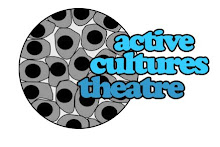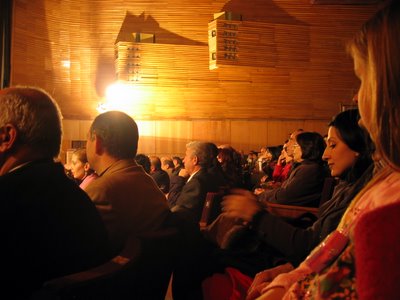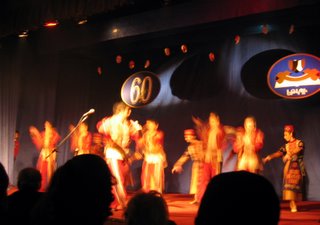An American Dramaturg in Armenia
Reflections on a 5-month sojourn as a Fulbright Scholar to the Yerevan Institute for Cinematography and Theatre
About Me

- Name: Ph. D. McResing
artistic director of Active Cultures, the Vernacular Theatre of Maryland
Tuesday, December 13, 2005
Friday, December 09, 2005
Performances by Armenian Theatre Students
Although, as I said on an earlier post, theatre is in some ways its own nation, with traditions and codes that transcend geographic and cultural boundaries, it more closely resembles more a republic than a dictatorship. The member republics may be united by common goals and structures, but each has its individual idiosyncrasies, its quaint phrases and its surprising regional dishes.
For example, at the Theatre Institute where I teach, the students study movement, vocal production, diction, script analysis, dramatic literature, directing and acting (including the Stanislavski method) just as my students in US might. But they are also trained in mime, clowning, folk dance and song. Some students combine this training with the study of circus techniques. Graduates of the school go on to work in major theatres, in Armenian and Russian television, radio, and film, but they also regularly perform as folk (national or narodnii) dancers and some even go on to join the circus.
On Sunday, I went to an evening of student performances in honor of the 60th Anniversary of the State Institute of Cinematography and Theatre. In many ways, the performance was virtually indistinguishable (language aside) from the student performances I saw in the theatre departments at NYU, the University of Michigan, Catholic University and the University of Maryland in my years as a student and teacher. There were dramatic scenes, comedic scenes, skits, arias from operas, there was even a number from A Chorus Line. And like all of those performances, it went on way too long (deeply disturbing the dramaturg in me). But never before have I seen a theatre student twirl four rings of flame at the same time. Nor have I seen so many students--what seemed to be the majority of the student body--perform intricately choreographed folk dances.
Folk dance is clearly a national obsession in Armenia in a way that someone from a heterogeneous culture like that of the United States finds difficult to absorb. It is taught to school children, occurs spontaneously at many social gatherings, forms a major or minor part of most events and public performances and is frequently seen on television. Almost everyone knows the basic dances and moves. Although one professional dancer I know claims its cultural dominance is being challenged by the undeniable popularity of Latin dance forms such as flamenco and samba, I doubt that. Armenian national folk dance seems here to stay.
Is there an American equivalent? The Chicken Dance? The Electric Slide (boogie, oogie, oogie)? Square dancing? Step competitions? I don't think so. Just as there is no single American culture, there is no single national dance. But it is becoming increasingly clear to me that although American has no single "folk" culture, there is great deal of homogeneity on the American stage.
For example, at the Theatre Institute where I teach, the students study movement, vocal production, diction, script analysis, dramatic literature, directing and acting (including the Stanislavski method) just as my students in US might. But they are also trained in mime, clowning, folk dance and song. Some students combine this training with the study of circus techniques. Graduates of the school go on to work in major theatres, in Armenian and Russian television, radio, and film, but they also regularly perform as folk (national or narodnii) dancers and some even go on to join the circus.
On Sunday, I went to an evening of student performances in honor of the 60th Anniversary of the State Institute of Cinematography and Theatre. In many ways, the performance was virtually indistinguishable (language aside) from the student performances I saw in the theatre departments at NYU, the University of Michigan, Catholic University and the University of Maryland in my years as a student and teacher. There were dramatic scenes, comedic scenes, skits, arias from operas, there was even a number from A Chorus Line. And like all of those performances, it went on way too long (deeply disturbing the dramaturg in me). But never before have I seen a theatre student twirl four rings of flame at the same time. Nor have I seen so many students--what seemed to be the majority of the student body--perform intricately choreographed folk dances.
Folk dance is clearly a national obsession in Armenia in a way that someone from a heterogeneous culture like that of the United States finds difficult to absorb. It is taught to school children, occurs spontaneously at many social gatherings, forms a major or minor part of most events and public performances and is frequently seen on television. Almost everyone knows the basic dances and moves. Although one professional dancer I know claims its cultural dominance is being challenged by the undeniable popularity of Latin dance forms such as flamenco and samba, I doubt that. Armenian national folk dance seems here to stay.
Is there an American equivalent? The Chicken Dance? The Electric Slide (boogie, oogie, oogie)? Square dancing? Step competitions? I don't think so. Just as there is no single American culture, there is no single national dance. But it is becoming increasingly clear to me that although American has no single "folk" culture, there is great deal of homogeneity on the American stage.
Friday, December 02, 2005
Reuben Gevorgyants' Gala Birthday

In the last few months, I have been to many theatre events here in Yerevan but on Wednesday I went to my first film-related event. Reluctantly, I must admit that film people in Yerevan are way cooler than theatre people. The standard theatre crowd is, in general, stunningly conservative in dress. The men, their hair tightly cropped, wear suits or dress in black from head to toe. Almost universally, the women are impecably groomed, have long, beautiful hair, and totter around on high-heeled, pointy-toed shoes.
In contrast, the film world is full of color and variety. The women wear skirts of many patterns and lengths, boots and shoes of every desciption, and sport imaginative hairstyles in a variety of colors. The men have long hair, short hair, are clean shaven or bearded and, generally, seem oblivious to the world of black clothing.
And where do the film people hang out? In this instance, they were at a gala celebration of film director Ruben Gevorgyants' birthday. The event was held at the Cinema House, a large film theatre which Gevorgyants has run for the last 16 years. I was invited because my son took part in a special recitation by school children in honor of Mr. Gevorgyants.
The party was a cross between a roast and a variety show, with singers, musicians, actors and comedians performing in honor of the birthday boy. Even Sos Sargsian, the actor/director/painter/nationalist/political activist who heads the institute where I teach, was there.
There were many amusing tidbits scattered throughout the evening, such as a very silly skit involving a quilt and disappearing and reappearing characters in narodnii costumes, or the all-Armenian impression of George W. Bush, and expecially the presentation of a marionette portrait of Gevorgyants. But my favorite thing was a documentary of Gevorgyants with his film students in which they travelled to the ancient temple of Garni and picked up trash.
After the performances, there was an amazing buffet in lobby--caviar, cheeses, dried fruits, a magnificent multi-tiered cake and, of course, Armenian wine. The lobby was a who's who in the Armenian performing arts world.











